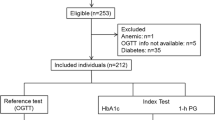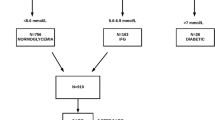Abstract
To evaluate HbA1c as a diagnostic tool in prediabetes—impaired fasting glucose (IFG) and impaired glucose tolerance (IGT), and newly detected diabetes (NDD), defined by plasma glucose and OGTT. 2,231 subjects, of mean age 50.3 ± 13.9 years and mean BMI 29.5 ± 6.2 kg/m2, underwent an OGTT. HbA1c performance was assessed using the area under the receiver operating characteristics curve (AUC-ROC). HbA1c was significantly higher in all groups with altered glucose tolerance—5.72 ± 0.61% in IFG, 5.84 ± 0.63% in IGT, and 7.5 ± 1.69% in NDD when compared to normal glucose tolerance—5.23 ± 0.65% (P < 0.0001). HbA1c of both prediabetic groups was significantly lower in comparison with NDD (P < 0.0001); in IGT being significantly higher than in IFG (P = 0.02). ROC analysis demonstrated good performance of HbA1c for diagnosing diabetes—AUC-ROC 0.958 (95% CI: 0.946–0.970), as well as prediabetes—AUC-ROC 0.729 (95% CI: 0.702–0.755). The optimal cut-off level of HbA1c for diagnosing diabetes was 6.1% (sensitivity 86%, specificity 92%) and for undiagnosed prediabetes—5.5% (sensitivity 71%, specificity 64%). HbA1c appears to be a useful, convenient, and reliable tool for identifying subjects with prediabetes and diabetes and should be considered in the development of diagnostic strategies.



Similar content being viewed by others
References
International Diabetes Federation (2009) IDF diabetes atlas, 4th edn. International Diabetes Federation, Brussels
Harris MI (1993) Undiagnosed NIDDM: clinical and public health issues. Diabetes Care 16:642–652
Harris MI, Klein R, Welborn T, Knuiman MW (1992) Onset of NIDDM occurs at least 4–7 yr before clinical diagnosis. Diabetes Care 15:815–819
Barr EL, Zimmet PZ, Welborn TA, Jolley D, Magliano DJ, Dunstan DW et al (2007) Risk of cardiovascular and all-cause mortality in individuals with diabetes mellitus, impaired fasting glucose and impaired glucose tolerance. The Australian diabetes, obesity and lifestyle study (AusDiab). Circulation 116:1–7
Diabetes Prevention Program Research Group (2007) The prevalence of retinopathy in impaired glucose tolerance and recent-onset diabetes in the diabetes prevention program. Diabet Med 24:137–144
Nguyen TT, Wang JJ, Wong TY (2007) Retinal vascular changes in prediabetes and prehypertension: new findings and their research and clinical implications. Diabetes Care 30:2708–2715
Sumner CJ, Sheth S, Griffin JW, Cornblath DR, Polydefkis M (2003) The spectrum of neuropathy in diabetes and impaired glucose tolerance. Neurology 60(1):108–111
World Health Organization (2006) Definition and diagnosis of diabetes mellitus and intermediate hyperglycemia. Report of a WHO/IDF consultation. WHO, Geneva
Saudek CD, Herman WH, Sacks DB, Bergenstal RM, Edelman D, Davidson MB (2008) A new look at screening and diagnosing diabetes mellitus. J Clin Endocrinol 93(7):2447–2453
Stern MP, Williams K, Haffner SM (2002) Identification of persons at high risk for type 2 diabetes mellitus: do we need the oral glucose tolerance test? Ann Intern Med 136:575–581
Tamborlane WV, Kollman C, Steffes MW, Ruedy KJ, Dongyuan X, Beck RW et al (2005) Diabetes Research in Children Network (DirecNet) Study Group. Comparison of fingerstick hemoglobin A1c levels assayed by DCA 2000 with the DCCT/EDIC central laboratory assay: results of a diabetes research in children network (DirecNet) study. Pediatr Diabetes 6(1):13–16
Kilpatrick ES, Winocour PH, On behalf of the Association of British Clinical Diabetologists (ABCD) (2010) ABCD position statement on haemoglobin A1c for the diagnosis of diabetes. Pract Diab Int 27(7):306–310
Lapolla A, Dalfrà MG, Fedele D (2010) Pregnancy complicated by diabetes: what is the best level of HbA1c for conception? Acta Diabetol 47(3):187–192
American Diabetes Association (2010) Standards of medical care in diabetes—2010. Diabetes Care 33(Suppl 1):S4–S10
American Diabetes Association (2011) Standards of medical care in diabetes—2011. Diabetes Care 34(Suppl 1):S11–S61
Saudek CD, Derr RL, Kalyani RR (2006) Assessing glycemia in diabetes using self-monitoring blood glucose and hemoglobin A1c. JAMA 295:1688–1697
Ollerton RL, Playle R, Ahmed K, Dunstan FD, Luzio SD, Owens DR (1999) Day-to-day variability of fasting plasma glucose in newly diagnosed type 2 diabetic subjects. Diabetes Care 22(3):394–398
Petersen PH, Jørgensen LG, Brandslund I, De Fine Olivarius N, Stahl M (2005) Consequences of bias and imprecision in measurements of glucose and HbA1c for the diagnosis and prognosis of diabetes mellitus. Scand J Clin Lab Invest 240:51–60
Sacks DB, Bruns DE, Goldstein DE, Maclaren NK, McDonald JM, Parrott M (2002) Guidelines and recommendations for laboratory analysis in the diagnosis and management of diabetes mellitus. Clin Chem 48(3):436–472
Selvin E, Crainiceanu CM, Brancati FL, Coresh J (2007) Short-term variability in measures of glycemia and implications for the classification of diabetes. Arch Intern Med 167(14):1545
Consensus Committee (2007) Consensus statement on the worldwide standardization of the hemoglobin A1C measurement: The American Diabetes Association, European Association for the Study of Diabetes, International Federation of Clinical Chemistry and laboratory medicine, and the International Diabetes Federation. Diabetes Care 30:2399–2400
Little RR (2003) Glycated hemoglobin standardization—National Glycohemoglobin Standardization Program (NGSP) perspective. Clin Chem Lab 41:1191–1198
Sacks DB (2005) ADA/EASD/IDF Working Group of the HbA1c Assay. Global harmonization of hemoglobin A1c. Clin Chem 51:681–683
International Expert Committee (2009) International expert committee report on the role of the A1C assay in the diagnosis of diabetes. Diabetes Care 32:1327–1334
American Diabetes Association (2010) Diagnosis and classification of diabetes mellitus. Diabetes Care 33(Suppl 1):S62–S69
American Diabetes Association (2011) Diagnosis and classification of diabetes mellitus. Diabetes Care 34(Suppl 1):S62–S69
World Health Organization (2010) Report of a WHO expert consultation. World Health Org., Geneva, 2011. http://www.who.int/chp/media/news/releases/2011_1_diabetes/en/index.html
Expert Committee on the Diagnosis, Classification of Diabetes Mellitus (1997) Report of the expert committee on the diagnosis and classification of diabetes mellitus. Diabetes Care 20:1183–1197
Davidson MB, Schriger DL, Peters AL, Lorber B (1999) Relationship between fasting plasma glucose and glycosylated hemoglobin: potential for false-positive diagnoses of type 2 diabetes using new diagnostic criteria. JAMA 281(13):1203–1210
(1995) The relationship of glycemic exposure (HbA1c) to the risk of development and progression of retinopathy in the diabetes control and complications trial. Diabetes 44(8):968–983
AACE/ACE (2010) A1C position statement. Endocr Pract 16(2):155–156
Lindstrom J, Tuomilehto J (2003) The diabetes risk score: a practical tool to predict type 2 diabetes risk. Diabetes Care 26:725–731
World Health Organization (1999) Definition, diagnosis and classification of diabetes mellitus and its complications. Part 1: diagnosis and classification of diabetes mellitus. Report of a WHO consultation. WHO, Geneva
Nakagami T, Qiao Q, Tuomilehto J, Balkau B, Tajima N, Hu G et al (2006) Screen-detected diabetes, hypertension and hypercholesterolemia as predictors of cardiovascular mortality in five populations of Asian origin: the DECODA study. Eur J Cardiovasc Prev Rehabil 13(4):555–561
Spijkerman AM, Adriaanse MC, Dekker JM, Nijpels G, Stehouwer CD, Bouter LM et al (2002) Diabetic patients detected by population-based stepwise screening already have a diabetic cardiovascular risk profile. Diabetes Care 25:1784–1789
Buell C, Kermah D, Davidson MB (2007) Utility of A1C for diabetes screening in the 1999–2004 NHANES population. Diabetes Care 30:2233–2235
Rohlfing CL, Wiedmeyer HM, Little RR, England JD, Tennill A, Goldstein DE (2002) Defining the relationship between plasma glucose and HbA(1c): analysis of glucose profiles and HbA(1c) in the diabetes control and complications trial. Diabetes Care 25(2):275–278
Ko GT, Chan JC, Yeung VT, Chow CC, Tsang LW, Li JK et al (1998) Combined use of a fasting plasma glucose concentration and HbA1c or fructosamine predicts the likelihood of having diabetes in high-risk subjects. Diabetes Care 21:1221–1225
Hu Y, Liu W, Chen Y, Zhang M, Wang L, Zhou H et al (2010) Combined use of fasting plasma glucose and glycated hemoglobin A1c in the screening of diabetes and impaired glucose tolerance. Acta Diabetol 47(3):231–236
Mohan V, Vijayachandrika V, Gokulakrishnan K, Anjana RM, Ganesan A, Weber MB et al (2010) A1C cut points to define various glucose intolerance groups in Asian Indians. Diabetes Care 33(3):515–519
Droumaguet C, Balkau B, Simon D, Caces E, Tichet J, Charles MA et al (2006) DESIR Study Group. Use of HbA1c in predicting progression to diabetes in french men and women: data from an epidemiological study on the insulin resistance syndrome (DESIR). Diabetes Care 29(7):1619–1625
Bennett CM, Guo M, Dharmage SC (2007) HbA(1c) as a screening tool for detection of type 2 diabetes: a systematic review. Diabet Med 24:333–343
Inoue K, Matsumoto M, Kobayashi Y (2007) The combination of fasting plasma glucose and glycosylated hemoglobin predicts type 2 diabetes in Japanese workers. Diabetes Res Clin Pract 77:451–458
Perry RC, Shankar RR, Fineberg N, McGill J, Baron AD, Early Diabetes Intervention Program (EDIP) (2001) HbA1c measurement improves the detection of type 2 diabetes in high-risk individuals with nondiagnostic levels of fasting plasma glucose: the early diabetes intervention program (EDIP). Diabetes Care 24(11):465–471
Zhou X, Pang Z, Gao W, Wang S, Zhang L, Ning F et al (2010) Performance of an A1C and fasting capillary blood glucose test for screening newly diagnosed diabetes and pre-diabetes defined by an oral glucose tolerance test in Qingdao, China. Diabetes Care 33(3):545–550
Acknowledgments
This study was supported by a grant (308/2007) of the Ministry of Education and Science, Bulgaria.
Conflict of interest
The authors state they have no conflict of interest.
Author information
Authors and Affiliations
Corresponding author
Rights and permissions
About this article
Cite this article
Tankova, T., Chakarova, N., Dakovska, L. et al. Assessment of HbA1c as a diagnostic tool in diabetes and prediabetes. Acta Diabetol 49, 371–378 (2012). https://doi.org/10.1007/s00592-011-0334-5
Received:
Accepted:
Published:
Issue Date:
DOI: https://doi.org/10.1007/s00592-011-0334-5




